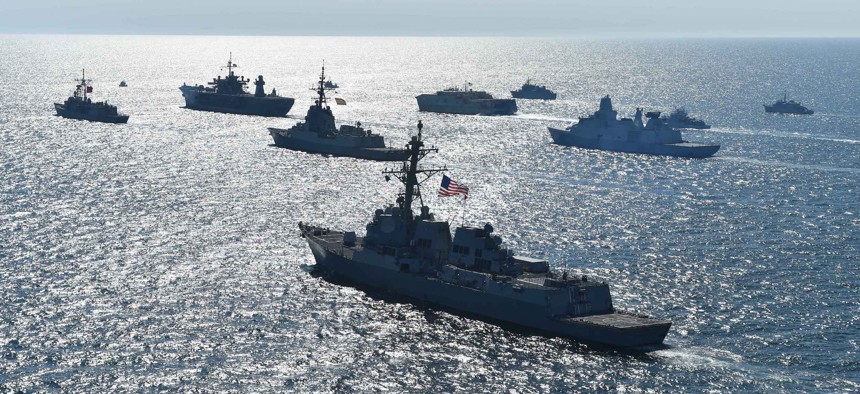
Thirty maritime unit ships from 12 nations maneuver in close formation for a photo exercise during Exercise Baltic Operations (BALTOPS) 2018 in the Baltic Sea. U.S. Navy / Mass Communication Specialist 1st Class Justin Stumberg
NATO Already Vastly Outspends Russia. Its Problems Are Not About Money.
The alliance’s security issues can’t be fixed by a traditional military buildup.
President Trump’s dismissal of Russian interference in the 2016 election – choosing to believe Vladimir Putin over U.S. intelligence and law enforcement agencies – has rightly sparked outrage and astonishment. But we shouldn’t let Trump’s disgraceful performance in Russia overshadow the other key issues raised by his recent trip.
In particular, Trump’s tantrum over the need for NATO allies to spend more on defense deserves greater scrutiny. Whether the goal is 2 percent of GDP – the alliance’s long-stated goal – or 4 percent, a fantastic figure Trump floated as well – the real question is whether NATO or the United States need to spend more on traditionally military assets to ensure their security. Contrary to Trump’s assertions, the answer is no.
According to the Stockholm International Peace Research Institute, the 29 members of the NATO alliance spent a cumulative $900 billion on defense last year, while Russia spent $66 billion. Even allowing for the fact that much of the U.S. share of that total is spent on global security challenges, NATO far outspends Russia. The top four European spenders – France, Germany, the United Kingdom, and Italy – together spend more than two-and-one-half times what Russia does. If security is just about who spends the most money, NATO is already far ahead of Moscow. The real question is what NATO countries spend their money on.
The Russian challenge does not require a buildup of costly military assets like tanks, aircraft, or ships. Russian tanks will not be rolling into East and Central Europe, and NATO aircraft will not be engaging in aerial dogfights with Russian planes. The biggest Russian threats to the United States and Europe are potential cyberattacks, political interference through the systematic deployment of funds and propaganda, and, possibly, the kind of hybrid warfare Moscow waged in Ukraine. None of these threats can be effectively addressed by accumulating more traditional military power.
Related: NATO’s Most Urgent Pledge Isn’t 2%-of-GDP. It’s Better Cyber Defense
Related: The 2% Benchmark Is Blinding Us to NATO Members’ Actual Contributions
For Europe, the best route to greater security will involve addressing its most pressing internal problems, from combatting the rise of right-wing, and in some cases neo-fascist parties; finding an equitable solution to its refugee crisis; and reforming its political and economic system to give hope to those left behind by European integration. These changes will make it harder for right-wing parties to get political traction, and will make European citizens less vulnerable to Russian propaganda efforts.
As for military spending, the challenge remains what it has been for some time: crafting a coherent Europe-wide force, or at least a grouping of national forces that can act in an integrated fashion in a crisis. This will involve the ability to deploy well-trained troops to crisis points rapidly. It will also require, to the extent politically possible, an effort to reduce redundancy in procurement that wastes a significant portion of the continent’s current military investments.
The one threat that President Trump can and should address is the continuing nuclear challenge posed by the possession of massive overkill by Washington and Russia. Progress on arms control is complicated in the short-term by Trump’s loss of credibility in the United States and globally due to his erratic behavior and uncritical embrace of Vladimir Putin. But at a minimum, Trump should agree to extend the New START nuclear arms agreement, which benefits U.S. security by limiting U.S. and Russian nuclear deployments to 1,550 weapons each, and, as or more importantly, gives the U.S. the ability to inspect and monitor nuclear developments in Russia.
All of the above is not meant to deny one of Trump’s underlying points, however clumsily expressed. America’s European allies should indeed shoulder a greater share of their own defense. But that effort should be tied to a revised defense strategy that addresses current threats, not an arbitrary spending goal that may or may not meet the continent’s most urgent defense needs.



